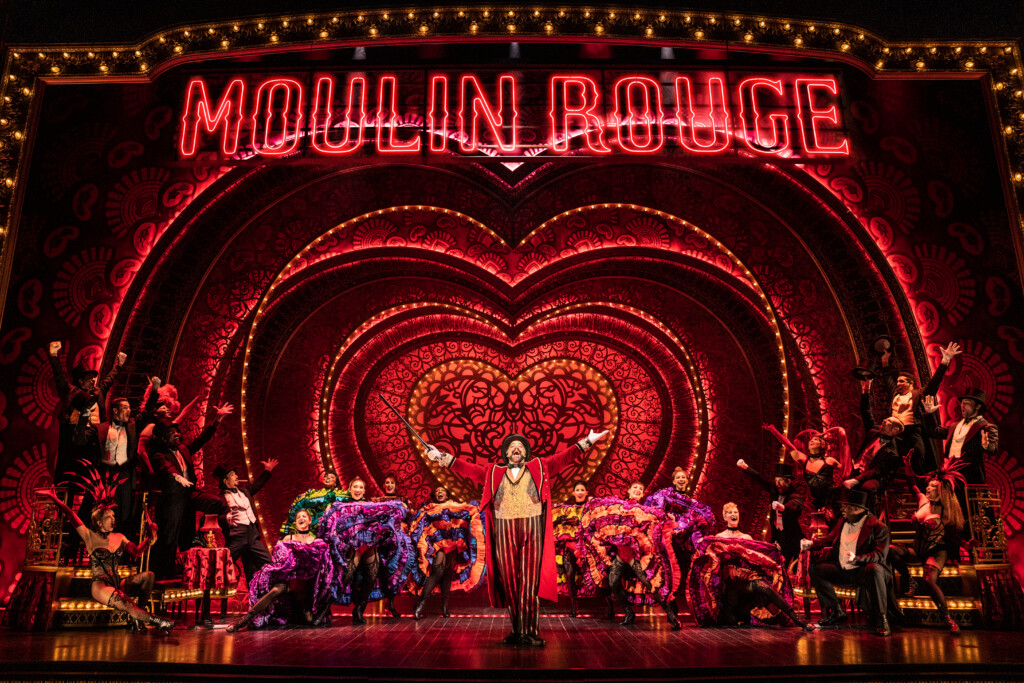Moulin Rouge! (2001)

Moulin Rouge! (2001) is a visually stunning and emotionally captivating musical film that has become a defining piece in modern cinema. Directed by Baz Luhrmann, the film is a passionate and extravagant blend of romance, music, and visual spectacle, offering a reimagining of the classic Orpheus myth set in the bohemian world of Paris at the turn of the 20th century. Known for its bold and imaginative style, Moulin Rouge! pushes the boundaries of the musical genre by combining elements of opera, theater, and pop music, creating a one-of-a-kind cinematic experience. At its heart, Moulin Rouge! is a story of forbidden love, the power of art, and the eternal tension between passion and societal constraints.
Set in 1899 in Paris, Moulin Rouge! takes place at the famed cabaret of the same name, a flamboyant and decadent venue where the worlds of music, art, and pleasure collide. The film’s protagonist, Christian (Ewan McGregor), is a young and idealistic writer who moves to Paris to pursue his dreams and join the bohemian movement. He becomes involved with the Moulin Rouge after meeting the beautiful and enigmatic Satine (Nicole Kidman), a star of the cabaret who also happens to be the lover of the wealthy and manipulative Duke of Monroth (Richard Roxburgh).
Christian and Satine fall deeply in love, but their romance is complicated by Satine’s position as a courtesan and the pressures of her life within the cabaret, where she is forced to maintain a relationship with the Duke for financial reasons. As Christian and Satine’s love story unfolds, the film explores themes of art, love, sacrifice, and the pursuit of freedom in the face of societal constraints.
At its core, Moulin Rouge! is a modern reimagining of the ancient Greek myth of Orpheus and Eurydice, where Orpheus (Christian) must navigate the perils of the underworld (represented by the corrupt Duke and the world of cabaret) in order to rescue his love, Eurydice (Satine). The story is both tragic and beautiful, underscored by the constant tension between the joy of artistic expression and the sadness of personal loss.
The film’s characters are larger than life, both in personality and in the way they are portrayed. Christian, played by Ewan McGregor, is a passionate and naïve writer who believes in the power of love and art to change the world. His journey from innocence to heartbreak is one of the most emotionally resonant aspects of the film, and McGregor’s performance, particularly his musical numbers, captures the character’s vulnerability and idealism perfectly. His love for Satine is pure, and it is this love that drives the narrative forward.
Satine, portrayed by Nicole Kidman, is one of the most iconic characters in modern musical cinema. A talented and alluring performer, Satine is also a tragic figure who is caught between her desires for true love and the harsh realities of the world she inhabits. Kidman’s performance in the role is both captivating and heartbreaking; she brings depth and complexity to a character who is forced to navigate the moral and emotional conflicts of living in a world that exploits her beauty and talent. Her voice, too, is a standout element of the film, as she sings several of the film’s most memorable songs, including “Roxanne” and “Come What May.”
The supporting cast in Moulin Rouge! is equally memorable. The Duke of Monroth, played by Richard Roxburgh, is the film’s primary antagonist—a wealthy and entitled man who is possessive of Satine and will stop at nothing to keep her for himself. Roxburgh plays the Duke with a mix of smugness and cruelty, making him a fitting foil to Christian’s earnestness and passion. The film also features a colorful array of bohemian characters, including Toulouse-Lautrec (John Leguizamo), a disabled painter who becomes Christian’s friend and confidante, and the troupe of performers who work at the Moulin Rouge. Together, they form a tight-knit group that shares a love for art, beauty, and freedom, even as they are constrained by the societal and economic pressures of the time.
One of the most striking features of Moulin Rouge! is its music. The film is renowned for its eclectic and innovative soundtrack, which combines a wide range of genres and musical styles, from classic show tunes and opera to pop hits of the late 20th century. The film’s bold musical choices, which include covers of songs by artists like Elton John, David Bowie, and Madonna, add a modern flair to the traditional musical format. These familiar songs are reinterpreted in the context of the film, often serving as emotional anthems that reflect the characters’ internal struggles.
One of the most notable aspects of Moulin Rouge! is how it incorporates well-known pop songs into its narrative. The film’s centerpiece is the love song “Come What May,” which is an original composition that represents the unshakeable love between Christian and Satine. This song, performed by Ewan McGregor and Nicole Kidman, is one of the most iconic moments in the film, and its heartfelt lyrics capture the passion and sacrifice that define the couple’s relationship. Other musical numbers, like “Roxanne” (a tango rendition of The Police’s song) and “Lady Marmalade” (a high-energy cover of the hit song by Christina Aguilera, Lil’ Kim, Mýa, and Pink), are equally memorable and showcase the film’s eclectic musical style.
The music is not only a key element of the film’s appeal but also serves to advance the narrative. Songs are not merely interludes but are deeply connected to the emotional and thematic threads of the story. For instance, the song “Roxanne” becomes a pivotal moment in the film when Christian attempts to win Satine’s love while warning her about the dangers of her relationship with the Duke. The song’s desperate, pleading tone mirrors Christian’s internal turmoil and his fight to save Satine from her doomed circumstances.
Baz Luhrmann is known for his vibrant and bold visual style, and Moulin Rouge! is no exception. The film’s production design, costumes, and cinematography are all extraordinarily rich, creating a world that is both fantastical and grounded in the gritty realities of turn-of-the-century Paris. The art direction is both ornate and decadent, reflecting the excesses and glamour of the Moulin Rouge cabaret. The set designs are filled with lavish details—chandeliers, velvet drapes, neon lights, and opulent furnishings—which create a sense of a dreamlike world that is as beautiful as it is ephemeral.
Luhrmann’s use of color is also striking. The film often uses red—symbolic of both passion and danger—throughout the story. The red lighting in the cabaret is constant, emphasizing the sensual and dramatic nature of the Moulin Rouge. The film’s visual effects, which include rapid editing, slow-motion shots, and stylized transitions, heighten the intensity of the narrative, making the audience feel as if they are caught up in the rush of emotions and dreams that the characters experience.
At its heart, Moulin Rouge! is a story about love—love that is passionate, destructive, and ultimately, doomed. The film explores the complexities of love and sacrifice, particularly in the face of societal pressures. Christian and Satine’s love is built on idealism and dreams, but it is also marred by the reality of the world they inhabit. Satine’s role as a courtesan, forced to compromise her integrity to survive, symbolizes the tension between personal desire and the demands of society. The Duke, on the other hand, represents the oppressive forces that seek to control love and art for their own gain.
The film also delves into themes of art, beauty, and the power of performance. The bohemian characters in Moulin Rouge! believe in the transformative power of art, and they view love and performance as forms of rebellion against societal norms. This theme is beautifully encapsulated in the film’s final act, where Christian and Satine’s love is expressed through art, music, and performance, creating a cathartic and tragic climax.
Moulin Rouge! (2001) is a mesmerizing and unconventional musical that captivates its audience with its blend of romance, music, and visual spectacle. Directed by Baz Luhrmann, the film is a feast for the senses, using color, music, and choreography to tell a story that is both timeless and modern. It explores themes of love, sacrifice, and the pursuit of artistic freedom, while paying homage to the operatic traditions that influenced the story. Through its passionate performances, unforgettable music, and bold visual style, Moulin Rouge! stands as a modern classic in the musical genre, offering a thrilling cinematic experience that continues to resonate with audiences around the world.














